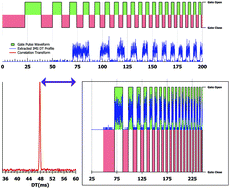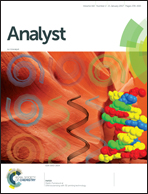Correlation ion mobility spectrometry†
Abstract
Using a linearly swept chirp function to modulate a Bradbury–Nielsen (BN) ion gate and application of a common signal processing technique (cross-correlation), we outline a method for obtaining high resolution IMS–MS spectra with ion gate duty cycles approaching 50%. Correlation IMS (CIMS) offers advantages over current multiplexing approaches in IMS–MS, which include the Hadamard and Fourier transforms, by minimizing transform artifacts while maintaining high ion throughput. Although cross-correlation techniques have been utilized previously in the field of IMS, to the best of our knowledge, this approach has not been utilized to obtain spectrum that resembles traditional IMS spectrum with resolving powers approaching the theoretical limit. This new approach relies on a linear sweep, which is a swept frequency signal, commonly utilized in different applications because of its compatibility with the fast Fourier transform (FFT). However, unlike spectra derived from Fourier transformation, CIMS yields data sampling rates that are not dependent upon terminal frequency and takes advantage of several factors unique to IMS operation; the non-linear response of ions at relatively low gate pulse widths, fluctuations in intensity, and peak profiles resembling the input gate pulse vector observed especially noted at low gating frequencies.



 Please wait while we load your content...
Please wait while we load your content...